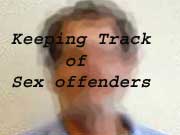|
Audio
Photos
Resources
Your Voice
|
A new approach to treating sex offenders
April 21, 2004
 |
| The Olmsted County Law Enforcement Center is the place where convicted sex offenders in the county spend time -- meeting with therapists and probation officers, and sometimes sitting in jail. (MPR Photo/Erin Galbally) |
Rochester, Minn. — It's a Tuesday afternoon and 10 men spread out around a long wooden conference table. Men in their 20s and 30s sit next to silver-haired grandfathers. There's at least one Rochester business owner in the group. A handful work in local restaurants or stores. Others are retired, under house arrest, or living in the county jail. All these men are convicted sex offenders. They've gathered here at the Olmsted County Government Center for group therapy.
The session begins with a man we'll call Dave. He's considered an old-timer, having been part of this group for several years. He's a larger fellow, and wears his hair in a graying pompadour. Dave's on probation for sexually molesting a girl. He talks about how he felt during a recent encounter with a new neighbor.
"The neighbor right across the road from me moved in last October or November. They have a little Jack Russell terrier, and it was in yard in the morning. And that afternoon I was pulling out and saw the guy in his driveway, and it went through my mind, 'Does he know I'm a sex offender? What does he know about me?' How am I going to deal with this," Dave tells the group.
By all accounts, Dave seems to be using treatment to change his behavior. He uses terms he's learned in treatment. He tries to identify 'triggers' that can set him off on bad behavior. When things get tough, he checks in with other group members with a 'buddy call.' All are staples of something called wound therapy, the particular brand of treatment administered here.
 | |||
Charles Dawley helped pioneer wound therapy, and he sits at the far end of the table listening intently as Dave speaks. Dawley believes the majority of sex offenders are amenable to treatment. And when he's not helping to facilitate groups like this one, he's evaluating new offenders to determine whether or not they should be sent to prison.
Dawley estimates that in seven out of 10 cases, he recommends intensive therapy and probation instead of incarceration. That's partly because 90 percent of the offenders who are sent directly to prison return to the community without having undergone any treatment at all. That can be a recipe for trouble.
"I believe that the majority of sex offenders are what we refer to as wounded. In other words, sometime during the course of their lifetime, they've suffered more damage than what their psyche can handle," Dawley explains. "And as a result, they've developed an excessive number of negative beliefs they hold to be true about themselves."
Dawley believes offenders act on those negative beliefs, and commit sex crimes to escape their problems.
"Sexual abuse is a medicator, in my perception. It allows one to be distracted where they hurt, and to get away from that pain," says Dawley. "So the concept is to not only have the offender take full responsibility for his inappropriate sex behavior -- which is the first thing you try to accomplish -- but also to understand that there is a reason for his offense."
At the heart of wound therapy is an attempt to make offenders change the way they think. If they can do that, the theory goes, they can begin to change their actions.
|
Sexual abuse is a medicator, in my perception. It allows one to be distracted where they hurt, and to get away from that pain. So the concept is to not only have the offender take full responsibility for his inappropriate sex behavior ... but also to understand that there is a reason for his offense.
- Charles Dawley |
Take Dave for example. Dave continues the story about encountering his new neighbor. He tells other people in the group how he felt.
"The belief that I was defective, I'm a bad person, feelings of being on edge a little bit. Concern and worry. I wasn't embarrassed at the time, but I would have gone there had he asked," Dave explains.
The other men in the group listen and chime in. Dave says if the neighbor had inquired about his past offenses he would have fessed up. And Dave says he would offer to stay away from the man and his wife.
Dawley's wound therapy has caught on. Several other counties around the state now use a textbook he designed as the cornerstone of their sex offender treatment curriculum.
Another component of the therapy process in the three southeastern Minnesota counties has also gained popularity. It's called the co-facilitated method, and it involves a therapist and probation officer jointly participating in group therapy.
The probation officer takes notes, and uses the information to check up on the offender out in the community. The officer also has the power to re-arrest offenders who aren't complying with the conditions of their parole. It adds an extra layer of consequence.
Therapist Charles Dawley says it's a model that seems to work.
"Having a probation officer in the group -- we can deal with pretty much all potential problems that could arise, both from a mental health standpoint and a corrections standpoint," says Dawley. "The offenders have a clear understanding of where the boundaries are in terms of who does what, and my being responsible for the therapeutic aspects and the corrections officer for the more court-oriented aspects."
We weren't able to record another group therapy session later that week. That's when members of the group turned on one of their own.
They found out that a middle-aged man who we'll call Harry had been fantasizing about his daughter. Harry had also come into contact with a former victim. Harry saw the woman walk into the store where he works, and he deliberately chose to wait on her.
The men around the conference table were furious. They told him he was dangerous and risk to the community. And after a short conference in the hallway, Charles Dawley and the probation officer in the session seemed to agree. Harry was re-arrested and sent back to jail.
He may be thrown out of the program for violating the terms of his probation. If that happens, Harry will serve out his sentence -- 12 years in prison.
|
News Headlines
|
Related Subjects
|

